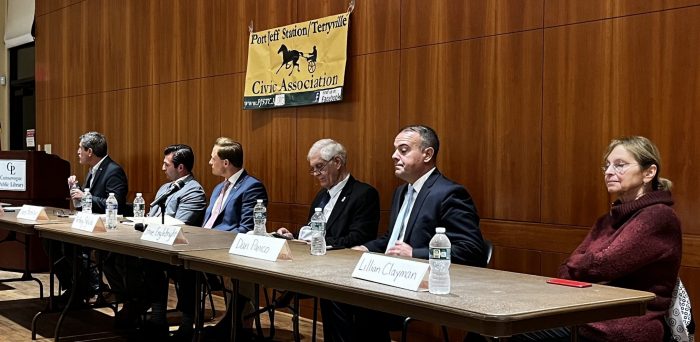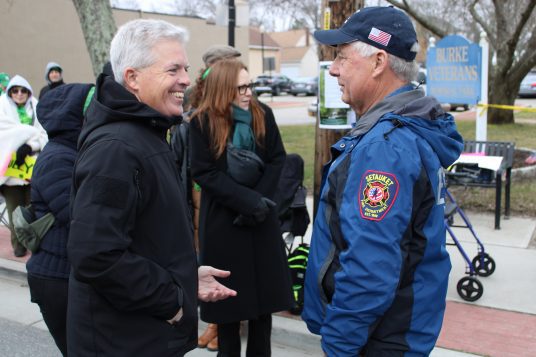Stony Brook University pre-health students step up as volunteer EMTs
By Lynn Hallarman
Stony Brook University master’s student Kelly Ng didn’t intend to be an emergency medical technician. Then, a friend took her to a training as part of the Port Jefferson Emergency Medical Services volunteer program.
“At first, I was tagging along,” Ng said. Her friend eventually quit the program, but Ng discovered she loved emergency care and the adrenaline rush of helping people.
I met with Ng and her fellow EMT, Adelaide Matthews, a junior also at Stony Brook, at the headquarters of the not-for-profit PJEMS, based in Mount Sinai. Both live at the station as part of the “bunk-in” program open to full-time university students. Matthews decided to undergo EMT training because “it seemed cool,” and thought it would be a good way to get hands-on experience in medicine. Both are planning on applying to either physician assistant school or medical school. Ng has been with the program for almost four years, and Matthews for two years.
PJEMS developed the bunk-in program as part of an organizational initiative to engage pre-health care university students as volunteer EMTs. “We had an urgent need to get creative in our approach to recruiting and retaining volunteer EMTs,” said Mike Presta, paramedic and deputy director of special operations for PJEMS. Presta saw the initiative as a win-win: Pre-physician assistant, pre-medicine and pre-nursing students would get the volunteer hours they need as part of their application process, and the organization would have a pipeline of volunteer EMTs.
In 2015, the Port Jeff organization started the College Student EMS Program. Students train to be full-fledged New York State-certified EMTS and respond to calls in the community alongside paid professionals. “They get invaluable experience as primary patient-care providers” Presta said.
At first, the organization focused on recruiting from the pre-PA program since they have the largest hourly volunteer requirement. “Then it just spread like wildfire because there weren’t a lot of opportunities like that around for the students,” Presta said.
In 2016, the bunk-in program was added. Students must be willing to commit to three eight-hour shifts per week. In return, the students get free room and board at the station and the opportunity to serve in leadership positions in their mentorship program. The bunk-in program is the first in New York state, according to Presta. “A couple of EMS upstate have replicated their program, but none locally,” he said. The Port Jeff College Student EMS Program currently has about 135 student volunteer EMTs, 15 of whom participate in the bunk-in program.
Over the years, Presta has seen a massive increase in the total number of calls per year as the population density in their coverage area has increased: “When I started here in 2007, I remember we broke 1,000 calls a year. And that was a big deal. But now, I can’t believe how busy it is. Last year, we did about 3,500 runs.”
A visit to Port Jeff EMS
The day I met with Ng and Matthews, the station was quiet. A cluster of unassuming low-slung buildings houses PJEMS on the corner of Route 347 and Crystal Brook Hollow Road. A row of ambulances sits in front of the garage, repurposed as a makeshift gym.
The rear of the building has been extended with a trailer unit to make room for the bunk-in program, which now replaces the spaces in the main building once used for offices. The largest space in the building is part command control and part community center, with a circle of comfy oversized recliners meant for weary bodies in need of rest between runs. A spotless kitchen overlooks a fenced-in backyard designed for the canine unit. Big screens line a wall, tracking deployed crews. EMT students — “probies” (shorthand for “on probation”) — lounge around a conference room table in Uggs and sweatpants, waiting for a teaching session to start.
PJEMS is the primary ambulance service for the village of Port Jefferson, Belle Terre and Mount Sinai. According to its website, the coverage area comprises several schools, hospitals, medical facilities, a ferry terminal, two harbors and 6 miles of residential and commercial waterfront on the Long Island Sound.
The organization is one of the region’s few “station-based” response units, meaning every shift has two professional paramedics and a crew of volunteer EMTs on site 24/7. The system is tightly designed with checks and oversight. Paramedics are trained in advanced lifesaving techniques beyond the basic skills learned by EMTs. No Port Jefferson volunteer EMT is left on their own or without backup from a paramedic.
PJEMS, which has existed since 1959, started as 100% volunteer. However, as the area’s population grew and demand increased, the service added paid staff. According to Presta, community residents represent only about 10% of the 150 total number of EMT volunteers, with the rest mostly university students — including those in the bunk-in program. Still, Presta wishes more residents were interested in volunteering. “But there is no sell,” he said. “A person must have a strong intrinsic motivation to serve.”
New York State EMS crisis
In 2019, a NYS Emergency Services Medical Council report identified insufficient EMS workforce reaching critical levels. EMS agencies statewide identified workforce shortages as impairing their ability to respond to need, causing delayed response times or resulting in missed calls.
The report identified a tsunami of circumstances that have led to the workforce shortage, including the aging of volunteer EMTs, lack of pay equity for professional EMTs and antiquated insurance reimbursement models. Add in an uptick in mental health calls, older patients with complex care needs plus drug and alcohol-related calls, EMS programs across the state started showing signs of critical strain. These problems worsened during the COVID-19 pandemic, with an alarming overall drop in volunteerism to today’s levels, characterized by the NYS Association of Counties as a crisis.
I was surprised to learn from state Sen. Monica Martinez (D-Brentwood) that EMS are not designated as essential services by New York State. I met with the senator at her office in Hauppauge to better understand the statewide response to the EMT crisis. Martinez has been at the forefront of advocating for policy changes at the state level as part of a legislative initiative called Rescue EMS. She has sponsored or co-sponsored several bills meant to bolster the volunteer EMT workforce, including increases in tax credits for volunteer EMTs, establishing a “Vets to Vollies” program which encourages veterans to join their local EMS or fire department and establishing a 90-day death benefit payment for volunteer EMTs and firefighters.
Martinez loves what PJEMS is doing with its student program, and imagines replicating the program in her 4th District at perhaps the high school level or as part of their junior leadership program.
Ng and Matthews are happy to be part of the Port Jefferson EMS first responder community. “It’s not just the medical knowledge we learn, it’s about how to talk to people and get them to trust us,” Matthews said. “And I really like the crew I work with.”































































